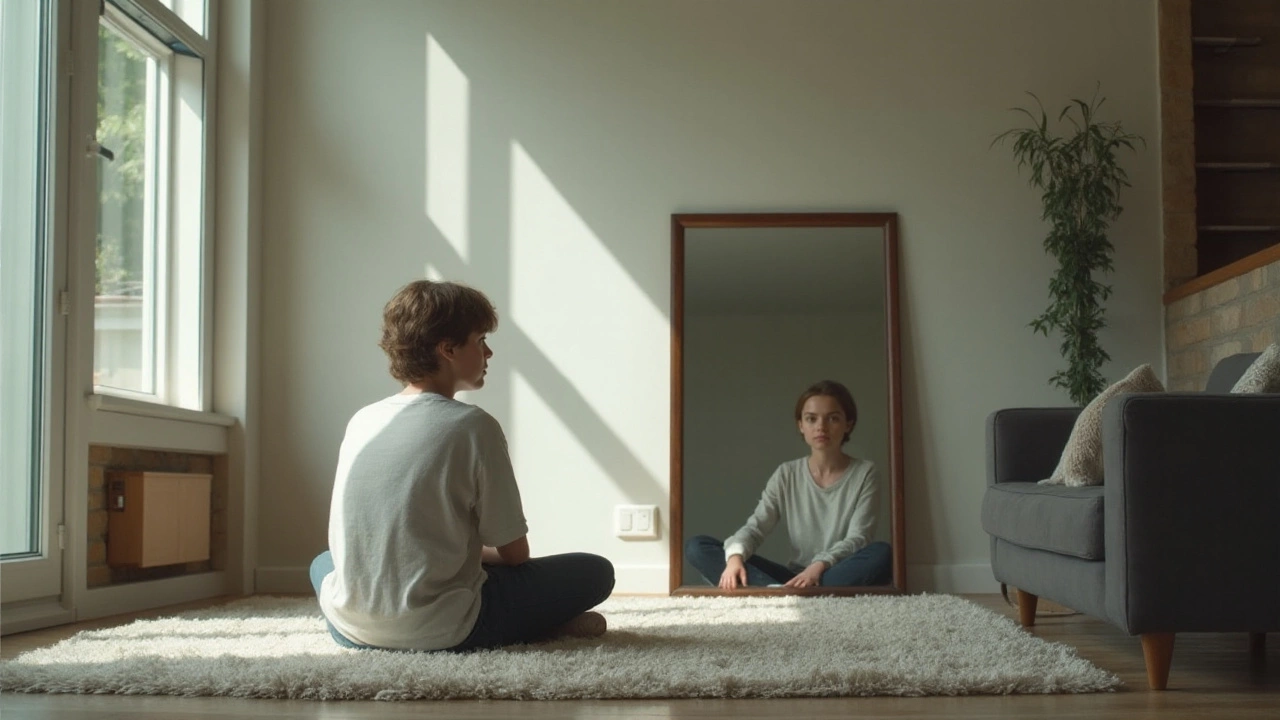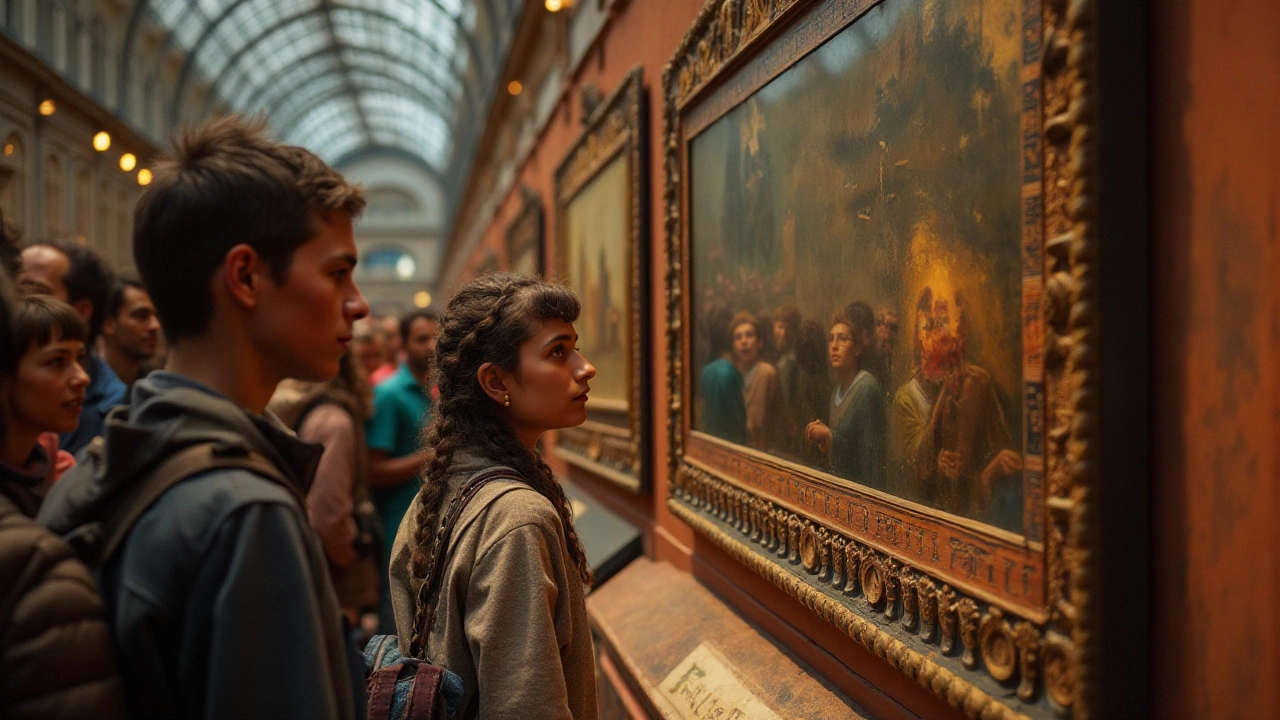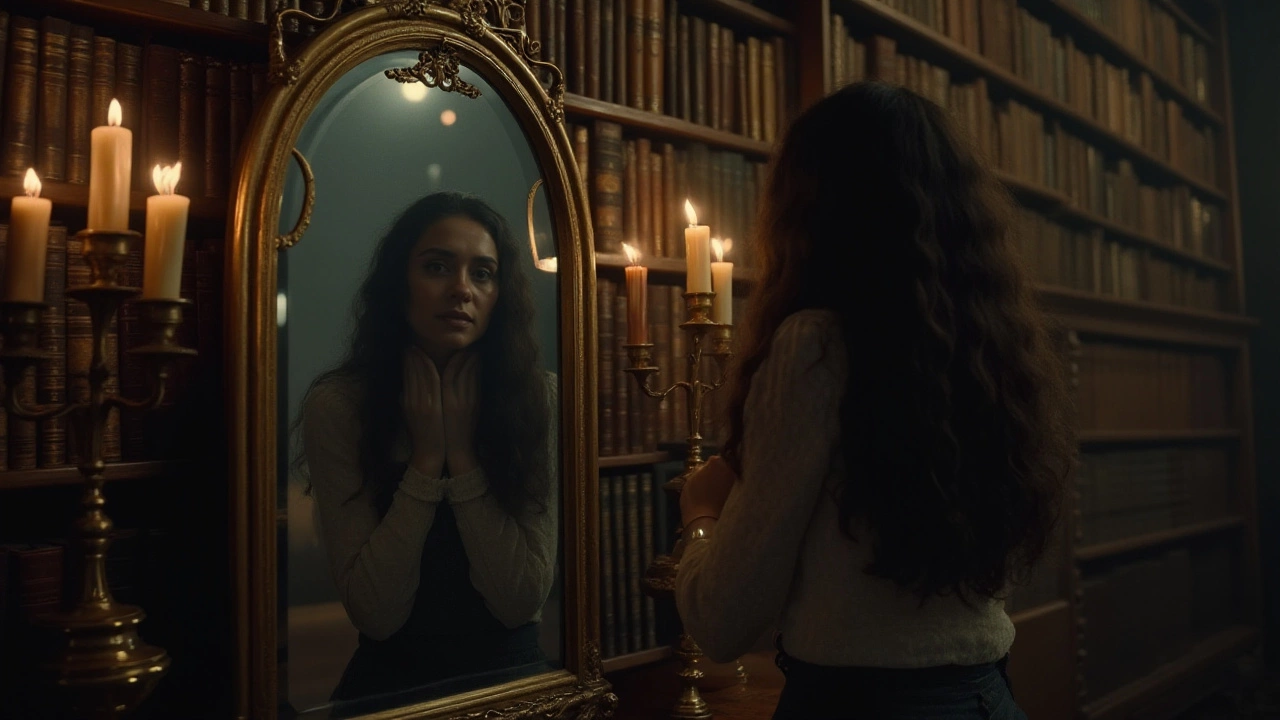Mirrors are everywhere—an integral part of modern life, yet they hold a mysterious allure that can evoke fear in some. Whether it's the reflection of a dimly lit room at night or just the quick glimpse of oneself that feels unsettling, understanding the reasons behind this fear is quite intriguing. Though we encounter them daily, many of us might not have given much thought to why mirrors can stir such strong emotions.
Our interactions with mirrors have a deep-rooted history that dates back to ancient civilizations. From scrying in mystical practices to everyday self-reflection, mirrors serve various roles. Yet, regardless of their widespread use, they can still trigger peculiar feelings of anxiety or discomfort. Delving into the realms of psychology, culture, and identity helps us unravel this complex relationship. By exploring these facets, we can gain helpful insights and practical tips on embracing mirrors as a harmonious aspect of our visual world.
- The Historical Context of Mirrors
- Psychological Perspectives on Mirror Fear
- Cultural Influences on Our Perception of Mirrors
- The Role of Self-Perception and Identity
- Tips for Overcoming Mirror-Related Anxiety
The Historical Context of Mirrors
Mirrors have been a significant part of human history long before they became the common household item we know today. From polished stones to elaborate glass works, the journey of the mirror is one of craftsmanship and cultural significance. The earliest known mirrors date back over 6,000 years to ancient Egypt and Mesopotamia, where polished obsidian or volcanic glass served as rudimentary reflections of one's likeness. These early items were not only functional but often revered, seen as magical and deeply mystical objects that could connect the physical with the spiritual realm.
As time progressed, mirrors became more sophisticated. The Romans, for instance, utilized polished metal surfaces, usually of bronze, and sometimes silver. These mirrors, while still crude by modern standards, were treasured possessions, often engraved with intricate designs and embedded in decorated frames. A wider availability came with the development of glass mirrors around the first century AD. However, these were exclusive luxury items reserved mostly for the wealthy.
The pivotal moment in mirror history came during the Renaissance, particularly in Venice. The city became the epicenter of advanced mirror manufacturing techniques. Venetian artisans discovered the secret of coating glass with a thin layer of mercury, producing reflections with remarkable clarity and precision unseen before. These mirrors were so highly valued that the techniques were kept secret, and any breach would be punishable by severe consequences. Such mirrors not only commanded high prices but also carried an aura of enchantment, often linked to notions of vanity and self-obsession, as seen in cultural references like the story of narcissistic reflection.
"In the 17th century, mirrors became commonplace, yet they still retained an otherworldly quality. Their capacity to reflect light made them coveted not just for beauty but for function, transforming dark spaces into brighter, more open places," noted Patricia Fara, a historian of science.
The spread of mirrors during the Enlightenment reflected a broader cultural shift toward self-awareness and personal identity. Many believed that these reflective surfaces could even predict the future or reveal truths unseen by the naked eye. Such beliefs infiltrated folklore and fairy tales, making mirrors communal symbols of self-discovery and hidden truths.
Today, mirrors are ubiquitous objects, yet our fascination with them persists. Whether used in simple self-care routines or grand architectural designs, mirrors neither lose their sense of wonder nor their ability to provoke contemplation. Though the context may have evolved, their role as both practical objects and symbols of reflection remains deeply ingrained in human culture. And so, the journey of mirrors continues—both as a tool and as a muse across generations.
Psychological Perspectives on Mirror Fear
When you stand before a mirror, it's a moment of intimacy with yourself, yet this encounter can stir unexpected emotions for many. Psychologists have long been intrigued by why something so mundane as a reflection can evoke fear or discomfort. At the heart of this mystery is the notion that mirrors force us to confront our own image and confront aspects of our identity we might not be ready to face. The mirror reveals not just the superficial flaws but also reflects our self-esteem, mood, and even our social identity. Recognitions of inadequacies or aging can amplify feelings of unease.
The fear of mirrors, or spectrophobia, often resonates with self-perception theories in psychology. The idea is that seeing oneself in a mirror triggers profound questions about our personal identity. We might question if we like what we see or if we recognize the person staring back. For some, this pause can be deeply unsettling because it strips away our control over how we are perceived by others, posing a challenge to the carefully curated self-image we tend to project.
Dr. Brenda Stevenson, a clinical psychologist specializing in identity disorders, once noted, "Mirrors reflect our weaknesses as they relate to societal standards, and this can create a clash between the real self and the ideal self."
Moreover, developmental psychology illuminates how our relationship with mirrors changes over time. Children, around the age of 18 months, typically begin to recognize themselves in a mirror, marking an important milestone in self-awareness. However, as life progresses, this simple act of recognition grows in complexity, shaping—or sometimes warping—our self-perception. Adolescence, with its heightened sensitivity to appearance, can turn mirrors into arenas of self-critique. And for some adults, mirror anxiety persists, deeply rooted in past experiences that left lasting impressions on one's self-esteem.
Another interesting angle comes from cognitive science, examining how our brains process reflections. Our eyes take in the mirror image just as they do any other visual stimulus, yet the brain must quickly assess whether this familiar face aligns with self-awareness. In certain cases, as in cotard delusion, individuals believe they are dead or do not exist, leading to a disturbing disconnect when facing a mirror. Such conditions highlight the fragile nature of the human psyche when merged with the ever-present self-reflection in mirrors.
If we consider cultural differences, Western societies often place high emphasis on individual appearance, seen as a crucial element of one's identity. This societal pressure can exacerbate anxiety or fear surrounding mirrors. In contrast, other cultures may value collectivism more, potentially reducing the individual pressure over one's appearance. This showcases how psychology and culture entwine in influencing our emotional response to mirrored surfaces.
To mitigate fear associated with mirrors, psychologists often recommend gradual exposure therapy or cognitive-behavioral techniques to reshape the perceptions and thoughts that heighten fear. Embracing positive affirmations and grounding techniques can assist individuals in becoming more comfortable with their own reflection. Understanding these psychological dynamics offers a valuable pathway for those seeking to transform mirror fear into an opportunity for personal growth.

Cultural Influences on Our Perception of Mirrors
From the earliest days of humanity, cultures across the world have harbored a deep fascination with mirrors, viewing them through lenses of mysticism, superstition, and reflection. Each society brings its unique narrative, layering sacred meanings onto the simple act of seeing one’s reflection. In ancient Rome, mirrors were believed to trap souls, an idea that cascades through to various cultures and epochs, influencing perceptions even today. This intangible power is perhaps why mirrors are often associated with both curiosity and trepidation.
In Asia, notably in Chinese Feng Shui, mirrors are seen as powerful tools capable of warding off evil and bringing in positive energy. They serve as protectors of homes, reflecting and therefore neutralizing negative elements. However, this power also comes with warnings; for instance, mirrors should not be placed facing the bed to avoid disturbing one’s soul. These beliefs reflect a balance between reverence and caution, an acknowledgment of the mirror’s symbolic strength in daily life.
C.G. Jung once remarked, "Who looks outside, dreams; who looks inside, awakes." This profound statement emphasizes the dual nature of mirrors in not only showing us the world but also compelling us to introspect.
Over in Europe during the Middle Ages, mirrors held a particularly sinister reputation. Superstitions claimed that breaking a mirror would bring seven years of bad luck, a belief that curiously persists in modern times. This fear was rooted in the idea that mirrors could capture a part of one’s soul or essence, hence the misfortune associated with its breakage. Such beliefs woven into the fabric of daily life showcase how cultural narratives shape our interactions with these reflective surfaces.
Jumping to another continent, in African cultures, mirrors have also played a central role in spiritual practices and rituals. Often used by shamans and spiritual leaders, mirrors can be tools for divination, bridging the material and spiritual realms. This mystical use signals a respect for mirrors as not just objects of vanity but as conduits to higher understanding and wisdom. Consequently, the avoidance or fear of mirrors in certain contexts can be attributed to their perceived power in interacting with unseen worlds.
The Role of Media and Literature
Our cultural understanding of mirrors has also been shaped extensively by media and literature. Fairy tales like "Snow White" introduce us to mirrors as gateways to alternate selves – the famous "Magic Mirror" serves as a symbol of self-awareness and truth. Such narratives in literature play a significant role in embedding the concept of mirrors in our psyche as both revealing and concealing objects. The entertainment industry often portrays mirrors as ominous, especially in horror genres, depicting them as channels to alternate dimensions and hiding places for otherworldly entities. These portrayals leave a lingering sense of eeriness around standing alone with one’s reflection in a dark room.
The entwined cultural stories surrounding mirrors across eras highlight that their fear often comes from a deep-seated respect and awe for what they represent. By understanding the myriad of beliefs that color our perceptions, we can appreciate mirrors not only as mere reflective surfaces but as long-standing witnesses to humanity’s quest for self-understanding.
The Role of Self-Perception and Identity
Looking into a mirror might seem like a mundane act, but it plunges us into the heart of self-perception and identity. When you gaze at your own reflection, it’s not merely an appraisal of your outward appearance. Mirrors have an enigmatic quality that they not only reflect our physical form but also invite introspection. They compel us to confront our own self-image. This encounter can stir deep-seated feelings, sometimes leading to discomfort. Various psychological theories suggest that fear of mirrors, known as spectrophobia, can often be linked to distorted perceptions of self. For someone grappling with personal issues or self-esteem challenges, the reflection might speak volumes that resonate with inner conflicts, unsettling as it may be. This idea that the mirror reflects not just one's face but a more profound view of oneself can sometimes be overwhelming, unleashing a complex array of emotions tied to self-worth and identity.
A pivotal concept in understanding the mirror’s impact on our psyche is the mirror stage, a theory introduced by psychoanalyst Jacques Lacan. According to Lacan, this developmental stage marks a moment of identification when an individual recognizes themselves in the mirror for the first time. This recognition is bittersweet; on one hand, it acknowledges our existence, yet on the other, it highlights the disparity between the idealized image and the current self. This profound theoretical framework illustrates how mirrors, with their stark honesty, force us to reconcile who we are with who we perceive ourselves to be. It isn’t uncommon for people to struggle with self-perception, potentially leading to mirror-phobia.
"The mirror stage is a drama whose internal thrust is precipitated from insufficiency to anticipation." - Jacques Lacan
Our culture also plays a significant role in shaping our identity and perception in front of a mirror. Modern society, with its deep-held emphasis on beauty standards and visual appeal, often transforms mirrors into critical judges of our worthiness. The omnipresent influence of media and societal norms persuades individuals to strive for often unattainable ideals. The mirror, therefore, becomes a battleground for self-identity, where people face their insecurities and perceived flaws. This notion is particularly evident in teenagers and young adults, who are still constructing their sense of self. Constant exposure to airbrushed images in media fuels insecurity, turning mirror-checking into a psychological pressure point rather than a simple grooming routine, impacting their relationship with mirrors profoundly.
While all these factors contribute to human fear of mirrors, they also hint at opportunities for growth. Recognizing that mirrors are a mere reflection of the physical self, not a measure of one's value or capabilities, can be a liberating idea. By focusing on building a positive self-image and fostering self-acceptance, we can slowly transform these encounters into moments of self-appreciation. Educators and psychologists often recommend activities that promote body positivity and self-compassion. Encouraging practices, like keeping a gratitude journal for personal traits that are usually overlooked or appreciating efforts in others, bolster self-esteem, enhancing mental well-being. By fostering a kinder inner dialogue, an individual's identity becomes robust enough to face their mirror reflection without trepidation.
To further understand the intricate relationship we share with mirrors, consider the prevalence of mirror-based therapy in clinical settings. Therapists often use mirrors in cognitive behavioral therapy to address body dysmorphia or eating disorders, incredibly demonstrating their power to heal when guided appropriately. It underscores the potential for self-discovery and growth through reflective practices. Individuals are directed to observe themselves compassionately, separate from self-critical thoughts, reinforcing healthier self-perception. Engaging with mirrors mindfully not only helps in overcoming irrational fears but also paves the way for embracing our true selves. These practices highlight that the key to fear of mirrors lies within a deeper understanding and acceptance of one's identity over time.

Tips for Overcoming Mirror-Related Anxiety
For those who feel a dread when confronted with mirrors, overcoming this anxiety might seem daunting. Thankfully, there are several strategies that can help ease the discomfort associated with reflections. Understanding the root cause of this fear is crucial. Often, it is deeply linked to self-perception and past experiences. Therefore, addressing these underlying issues might require patient introspection and willingness to change one’s approach to self-reflection. Cognitive-behavioral therapy can sometimes be beneficial as it helps to transform negative thought patterns into more positive ones. Developing a healthier relationship with your own reflection involves challenging the distorted beliefs that influence your perception.
Another helpful method includes exposure therapy, where one gradually increases the time spent in front of a mirror while engaging in positive self-talk or focusing on aspects of oneself they appreciate. This gradual desensitization can significantly reduce overwhelming feelings of anxiety. Incorporating mindfulness techniques can also enhance this practice, as they foster a non-judgmental awareness of the present moment, making it easier to accept and appreciate the image staring back at you.
Sometimes using mirrors strategically can play a role in alleviating anxiety. For instance, positioning mirrors in well-lit areas where you have positive associations, or utilizing decor and frames on mirrors to soften their impact, may change how you react when you see your reflection. It's important to be patient and gentle with oneself during this process, as overcoming any fear doesn’t happen overnight. Encouraging oneself with affirmations and celebrating small victories can be remarkably empowering.
For some, alternatively engaging with the idea of reflection through creative outlets can be immensely helpful. Art, photography, or journaling can explore one's self-image from new perspectives, offering cathartic relief. Engaging with literature that addresses or reflects on mirror psychology and fears may provide a sense of shared experience and understanding. Anaïs Nin once said, "We don't see things as they are, we see them as we are." Acknowledging this can shift the focus toward self-growth, rather than the mirror itself.

